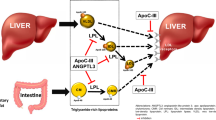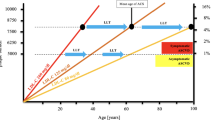Abstract
Lipoprotein (a) [Lp(a)] is the dominant lipid in atherosclerotic plaques though it is much less numerous than LDL or HDL in circulation. Molecular mechanism of selective uptake of Lp(a) into macrophages is unclear. Lp(a) was reported to form circulating immune complexes with the IgG-dominated plasma anti-α-galactoside antibody (anti-Gal) using the serine- and threonine-rich peptide sequences ( STPS) on its apo(a) subunit as surrogate ligand but left the other binding site of antibody free. We examined if these monovalent immune complexes could bind to smaller STPS-containing molecules on macrophage surface. Using placental membrane O-glycosylated proteins (PMOP) isolated by lectin affinity chromatography as model it was shown that human cell surface glycoproteins were small enough to occupy both binding sites of anti-Gal since they increased the fluorescence of FITC label at Fc part of anti-Gal and inhibited binding of anti-Gal and Griffonia simplicifolia lectin of similar specificity to immobilized ligands. Pre-incubation with anti-Gal facilitated Lp(a) attachment to macrophages unless anti-Gal-specific sugar was present. Anti-Gal-mediated attachment of apo(a) to macrophages increased with the number of apo(a) subunits. Further, anti-Gal-mediated binding of the same sample of apo(a) increased with the specific activity of anti-Gal sample. Finally binding of anti-Gal and anti-Gal-apo(a) complex to PMOP and macrophages respectively was mostly inhibited by LDL suggesting STPS as major anti-Gal epitopes on the cell surface. Results indicated that circulating Lp(a)-anti-Gal immune complexes anchor on macrophages using STPS-bearing cell surface glycoproteins as ligands and offer a pathway for Lp(a) sequestration into macrophages.







Similar content being viewed by others
References
Momiyama Y., Ohmori R., Fayad Z.A., Tanaka N., Kato R., Taniguchi H., Nagata M., Ohsuzu F.: Associations between serum lipoprotein(a) levels and the severity of coronary and aortic atherosclerosis. Atherosclerosis. 222, 241–244 (2012)
Solfrizzi V., Panza F., D’Introno A., Colacicco A.M., Capurso C., Basile A.M., Capurso A.: Lipoprotein(a), Apolipoprotein E genotype, and risk of Alzheimer’s disease. J. Neurol. Neurosurg. Psychiatry. 72, 732–736 (2002)
Kronenberg F., Kronemberg M.F., Kiechl S., Trenkwalder E., Santer P., Oberhollenzer F., Egger G., Utterman G., Willeit J.: Role of lipoprotein(a) and apolipoprotein(a) phenotype in atherogenesis: prospective results from the Bruneck study. Circulation. 100, 1154–1160 (1999)
Emanuele E., Peros E., Tomaino C., Feudatari E., Bernardi L., Binetti G., nMaletta R., Micieli G., Bruni A.C., Geroldi D.: Relation of apolipoprotein(a) size to alzheimer’s disease and vascular dementia. Dement. Geriatr. Cogn. Disord. 18, 189–196 (2004)
Pepin J.M., O’Neil J.A., Hoff H.F.: Quantification of apo[a] and apoB in human atherosclerotic lesions. J. Lipid Res. 32, 317–327 (1991)
Hoff, H.F., O’Neil, J., Smejkal, G.B., Yashiro, A.: Immunochemically detectable lipid-free apo(a) in plasma and in human atherosclerotic lesions. Chem. Phys. Lipids 67–68, 271–280 (1994).
Mayr M., Grainger D., Mayr U., Leroyer A.S., Leseche G., Sidibe A., Herbin O., Yin X., Gomes A., Madhu B., Griffiths J.R., Xu Q., Tedgui A., Boulanger C.M.: Proteomics, metabolomics, and immunomics on microparticles derived from human atherosclerotic plaques. Circ. Cardiovasc. Genet. 2, 379–388 (2009)
Libby P.: Inflammation and cardiovascular disease mechanisms. Am. J. Clin. Nutr. 83, 456S–460S (2006)
Peshkova, I.O., Shaefer, G., Koltsova, E.K: Atherosclerosis and aortic aneurisms: is inflammation a common denominator? FEBS Jl. 283, 1636–1653 (2016).
Galkina E., Ley K.: Immune and inflammatory mechanisms of atherosclerosis. Annu. Rev. Immunol. 27, 165–197 (2009)
Minick, C.R., Murphy, G.E.: Experimental induction of atheroarteriosclerosis by the synergy of allergic injury to arteries and lipid-rich diet. II. Effect of repeatedly injected foreign protein in rabbits fed a lipid-rich, cholesterol-poor diet. Am. J. Pathol. 73, 265–300 (1973).
Sandrin M.S., Vaughan H.A., Xing P.-X., McKenzie I.F.C.: Natural human anti-Galα(1,3)Gal antibodies react with human mucin peptides. Glycoconj. J. 14, 97–105 (1997)
Mandagini G., Subramanian S.P., Vasantha K., Appukuttan P.S.: Human plasma anti-α-galactoside antibody forms immune complex with autologous lipoprotein(a). Immunol. Investig. 42, 324–340 (2013)
Yamamoto T., Davis C.G., Brown M.S., Schneider W.J., Casey M.L., Goldstein J.L., Russell D.W.: The human LDL receptor: a cysteine-rich protein with multiple Alu sequences in its mRNA. Cell. 39, 27–38 (1984)
Geetha M., Kalaivani V., Sabarinath P.S., Appukuttan P.S.: Plasma anti-α-galactoside antibody binds to serine- and threonine-rich peptide sequence of apo(a) subunit in Lp(a). Glycoconj. J. 31, 289–298 (2014)
Jaison P.L., Appukuttan P.S.: Rapid isolation of human plasma anti-alpha-galactoside antibody using sugar-specific binding to guar galactomannan or agarose. Indian J. Biochem. Biophys. 29, 266–270 (1992)
Geetha M., Annamma K.I., Mathai J., Appukuttan P.S.: Normal human plasma anti-beta-glucoside antibody has markedly elevated IgA content and binds fungal and yeast polysaccharides. Immunol. Investig. 36, 73–83 (2007)
Hudson, L., Hay, F.C.: Practical Immunology. Blackwell Scientific (1980).
Kodama T., Reddy P., Kishimoto C., Krieger M.: Purification and characterization of a bovine acetyl low density lipoprotein receptor. Proc. Natl. Acad. Sci. U. S. A. 85, 9238–9242 (1988)
Panda S.K., Kumar S., Tupperwar N.C., Vaidya T., George A., Rath S., Bal V., Ravindran B.: Chitohexaose activates macrophages by alternate pathway through TLR4 and blocks endotoxemia. PLoS Pathog. 8, e1002717 (2012)
George G., Geetha M., Appukuttan P.S.: Antigen-induced activation of antibody measured by fluorescence enhancement of FITC label at fc. J. Fluoresc. 25, 1493–1499 (2015)
Sureshkumar G, Appukuttan PS,Basu D. 1982. Puriifcation and characterization of an α-galactoside binding lectin from jack fruit seed (Artocarpus integrifolia). J. Bioscie. 4, 257–261 (1982)
Cautrecases P. Anfinsen LB. 1971. Affinity chromatography. In. Methods Enzymol. 22: 345–378 (1971)
Kalaivani V., Appukuttan P.S.: Circulating Lp(a):LDL complexes contain LDL molecules proportionate to Lp(a) size and bind to galectin-1: a possible route for LDL entry into cells. Lipids. 49, 1101–1113 (2014)
Baues R.J., Gray G.R.: Lectin purification on affinity columns containing reductively aminated disaccharides. J. Biol. Chem. 252, 57–60 (1977)
Sastry M.V.K., Banerji P., Patanjali S.R., Swamy M.J., Swarnalatha G.V., Surolia A.: Analysis of saccharide binding to Artocarpus integrifolia lectin reveals specific recognition of T-antigen (beta-D-Gal(1-3)D-GalNAc). J. Biol. Chem. 261, 11726–11731(1986)
Sreekumar A., Mandagini G., Subramanian S.P., Sankunni A.P.: apoB-independent enzyme immunoassay for lipoprotein(a) by capture on immobilized lectin (jacalin). J. Immunoass. Immunochem. 34, 166–179 (2013)
Fless G.M., Santiago J.Y.: Molecular weight determination of lipoprotein(a) [Lp(a)] in solutions containing either NaBr or D2O: relevance to the number of apolipoprotein(a) subunits in Lp(a). Biochemistry (Mosc). 36, 233–238 (1997)
Schneider W.J., Beisiegel U., Goldstein J.L., Brown M.S.: Purification of the low density lipoprotein receptor, an acidic glycoprotein of 164,000 molecular weight. J. Biol. Chem. 257, 2664–2673 (1982)
Gaubatz J.W., Ghanem K.I., Guevara J., Nava M.L., Patsch W., Morrisett J.D.: Polymorphic forms of human apolipoprotein[a]: inheritance and relationship of their molecular weights to plasma levels of lipoprotein[a]. J. Lipid Res. 31, 603–613 (1990)
Fless G.M., ZumMallen M.E., Scanu A.M.: Physicochemical properties of apolipoprotein(a) and lipoprotein(a-) derived from the dissociation of human plasma lipoprotein (a). J. Biol. Chem. 261, 8712–8718 (1986)
Garner B., Merry A.H., Royle L., Harvey D.J., Rudd P.M., Thillet J.: Structural elucidation of the N- and O-glycans of human apolipoprotein(a): role of o-glycans in conferring protease resistance. J. Biol. Chem. 276, 22200–22208 (2001)
Zioncheck T.F., Powell L.M., Rice G.C., Eaton D.L., Lawn R.M.: Interaction of recombinant apolipoprotein(a) and lipoprotein(a) with macrophages. J. Clin. Invest. 87, 767–771 (1991)
Keesler G.A., Gabel B.R., Devlin C.M., Koschinsky M.L., Tabas I.: The binding activity of the macrophage lipoprotein(a)/apolipoprotein(a) receptor is induced by cholesterol via a post-translational mechanism and recognizes distinct kringle domains on apolipoprotein(a). J. Biol. Chem. 271, 32096–32104 (1996)
Lackner C., Boerwinkle E., Leffert C.C., Rahmig T., Hobbs H.H.: Molecular basis of apolipoprotein (a) isoform size heterogeneity as revealed by pulsed-field gel electrophoresis. J. Clin. Invest. 87, 2153–2161 (1991)
Victora, G.D., Nussenzweig, M.C.: Germinal Centers. Annu. Rev. Immunol. 30, 429–457 (2012).
Blake, R.C., Dalehanty, J.B., Khosraviani, M et al.: Allosteric binding properties of a monoclonal antibody and its Fab fragment. Biochemistry 42. 497–508 (2003).
Steinberg D.: Low density lipoprotein oxidation and its Pathobiological significance. J. Biol. Chem. 272, 20963–20966 (1997)
Melajärvi N., Gylling H., Miettinen T.A.: Sialic acids and the metabolism of low density lipoprotein. J. Lipid Res. 37, 1625–1631 (1996)
Li D., Mehta J.L.: Oxidized LDL, a critical factor in atherogenesis. Cardiovasc. Res. 68, 353–354 (2005)
Dousset, N., Dousset, J.C., Soléra, M.L., Valdiguié, P.: Desialylated low density lipoproteins and atherosclerosis. In: Emerit, D.I. and Chance, P.B. (eds.) Free Radicals and Aging. pp. 158–163. Birkhäuser Basel (1992).
Acknowledgements
Financial assistance to Binu S. in the form of Post Doctoral Fellowship from Kerala State Council for Science Technology and Environment, Government of Kerala is gratefully acknowledged. We are thankful to the surgeons and nursing staff of Cosmopolitan Hospital, Thiruvananthapuram for supplying placenta for this study. We are also grateful to Dr. Jaisy Mathai, Head, Department of Blood Transfusion Medicine of this institute for the outdated plasma samples provided.
Author information
Authors and Affiliations
Corresponding author
Ethics declarations
Conflict of interest
There is no conflict of interest of any sort in respect of any author or host institution.
Ethical approval
Experiments were carried out with approval of the Institutional Ethics Committee (IEC no: IEC/676 dated 16th August 2014).
Rights and permissions
About this article
Cite this article
Sheela, B., George, G., Mandagini, G. et al. Plasma anti-α-galactoside antibody mediates lipoprotein(a) binding to macrophages. Glycoconj J 33, 953–961 (2016). https://doi.org/10.1007/s10719-016-9713-z
Received:
Revised:
Accepted:
Published:
Issue Date:
DOI: https://doi.org/10.1007/s10719-016-9713-z




